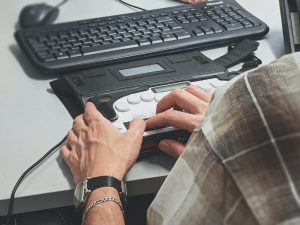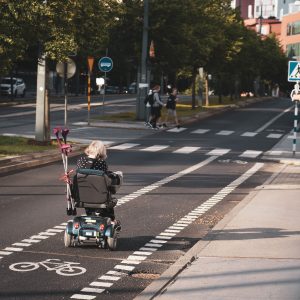Accessibility, Inclusivity & Climate Change Action
May 10, 2021
What does inclusivity and accessibility look like, what is the difference, and where do they fit within the fight against climate change? We often look at these concepts through a narrow lens however, they exist in every space, experience, policy, product, and service. Most of us separate these topics from our day-to-day, thinking of accessibility in terms of people, rather than a concept. But the truth is, accessibility and inclusivity are far-reaching, and impossible to isolate from other segments of society, including climate action and environmentalism.
People with disabilities make up approximately 15% of the global population, so it’s imperative that when we explore sustainable solutions, we consider how these might look within the context of disabilities. This is a vast discussion, so in this blog I will be limiting my focus to three primary questions: How does climate change affect people with disabilities in times of crises? Who is represented in the climate change conversation and policy-making, who is missing and why? And what can we do to bring inclusivity and accessibility into the environmental movement? To best answer these questions, we must first consider different types of disabilities, and how accessibility and inclusivity differ from one another.
As noted earlier, a significant number of people in the world have a disability, and most of us at some point in our lives will be included in that population. Some disabilities are permanent, while some are temporary or change over time. Some are visible or invisible, and some are physical, mental or cognitive.
Before we move on, take a moment to contemplate the different disabilities that exist. How many can you think of? In what ways are they similar or different from one another, and what accommodations might people with these disabilities require?
Accessibility and inclusively, although interconnected, are not identical concepts. While accessibility focuses on providing equitable access to all, inclusivity accounts for the different identities and cultures that exist within our community. Inclusivity recognizes how different identities intersect with one another, and how issues might affect us differently as a result.
This brings me to my first question:
1) How does climate change affect people with disabilities in times of crises?
With climate change comes an increase in extreme weather events such as hurricanes, forest fires and floods. In many places around the world, it has become essential that governments and communities have strategies in place to deal with environmental crises, such as natural disasters. But these strategies, whether planned or improvised, do not always account for the vast multitude of disabilities that might exist within a population.
Michelle Villeneuve of the University of Sydney explains that people with disabilities are at severe risks compared to people without a disability in times of crises:
People with [disabilities] are twice to four times more likely to be killed or injured in natural disasters than the general population. Deaf people may not hear early warning systems. People who cannot see, who have trouble walking, or who rely on wheeled mobility might find it difficult to flee and find protection
In addition to the challenges caused by physical disabilities in times of environmental disasters and extreme weather events, people with cognitive disabilities may have trouble reacting quickly or processing instructions. Power failures can affect assistive devices and necessary medical equipment, and an inequitable access to information may cause delays in receiving urgent notifications or warnings. Despite representing only 6% of the local population, almost 50% of deaths caused by Hurricane Katrina were those over the age of 75, a population with significantly higher rates of disability. As climate change increases the likelihood and severity of extreme weather events, people with disabilities are more vulnerable to the associated dangers such as injury or death. Therefore, it is crucial that people with disabilities are at the forefront of disaster planning and climate change policy-making.
So it is important for us to ask:
2) Who is represented in the climate change conversation and policy-making, who is missing and why?
People with disabilities bring unique perspectives, requirements, and insight into how we can design spaces and experiences to not only be ecologically sustainable, but accessible to all members of the community. Often however, people with disabilities are left out of the climate change conversation, and climate change solutions seldom account for the unique limitations and barriers that they face such as:
- An inability to access regular and accessible public transit
- A reliance on healthcare services primarily found in urban environments
- The reliance upon assistive technology or accessible coding in order to navigate digital spaces/resources
- The increased likelihood of experiencing income disparity due to limited employment opportunities
- Or even the required use of a straw to drink (straws of course, have become an environmental faux pas in recent years)

Although there are people with disabilities advocating for sustainability and climate change policy, their needs are still often overlooked by the mainstream environmental movement. Greta Thunberg is an encouraging example of how perspectives are shifting. Referring to her Asperger’s Syndrome and OCD as a “superpower”, Greta maintains that there is strength in our differences, and that her specific disability enables her to view climate change issues with clarity and focus. Her influence and platform are an indication that the space and opportunity for people with disabilities to participate in climate action discussions is growing, but there is still progress to be made on this front and we all have a role to play.
Lastly, and perhaps most importantly, my final question is:
3) What can we do to bring inclusivity and accessibility into the environmental movement?
People with disabilities and their caretakers are best equipped to determine their needs, and how their needs can be most effectively integrated within the fight against climate change. As previously mentioned, people with disabilities need to be actively engaged in creating policy, developing technology, and implementing solutions and strategies to fight climate change. But in order for this to be truly effective, all levels of community and government need to work in a collaborative and connected way, and the key principles of inclusion, participation, self-advocacy, accessibility and sustainability must be established at the root. The WHO Community Based Rehabilitation Matrix, a framework that outlines the rights of persons with disabilities, notes the importance of these principles to establishing a more equitable and inclusive global society.

While many opportunities exist at the provincial, national and global levels, there are also a number of great strategies that individuals or businesses can adopt in order to create positive, grassroots change.
So what are some simple actions that you do to make the environmental movement more accessible?
1) Do your research, ask questions, and don’t assume
There are a number of great resources available to help us better understand how to accommodate and include people with disabilities. CBC’s You Can’t Ask That, is both entertaining, informative, and normalizes disabilities. Better understanding the barriers that people with disabilities face will help us consider how climate change solutions might impact, include, or further marginalize them.
2) Take an accessibility training course, invite your friends or colleagues
In order to create accessible experiences, we all need to be informed and comfortable with accessible communication strategies. Inclusivity needs to be well-integrated within our personal and work cultures so that accessibility does not start and stop with specific processes. I recommend Accessibility Services Canada as an excellent resource for training and workshops.
3) Hire an interpreter for your next event or webinar
Does your work host virtual or in-person experiences? If registration is required in advance, provide your guests with the opportunity to self-identify any accessibility requirements they may have so that you can arrange appropriate accommodations. If the event is open, consider hiring an interpreter to be available on-site if needed and promote this service to the public.
For in-person events, be conscious of whether or not your space is wheelchair accessible, designate a separate room for people who may require a quiet or private space, and ensure chairs are available.
4) Make your organization’s content accessible
Share information in more ways than one. Use descriptive language to best accommodate members of your audience who might be visually impaired, and use visuals/text to share information to those who may be hearing impaired. If your organization has a digital presence, work with your web developers to ensure your content is accessible and meet AODA accessibility guidelines, which are largely regarded as the most robust and progressive accessibility guidelines in Canada.
5) Amplify the voices of people with disabilities
If you have a platform, use it. Share environmental and climate change content created by people with disabilities on your social media, at work, or in the classroom. By bringing diverse ideas to the forefront of the climate change discussion, we will ensure that solutions and ideas better represent our community,
Like all movements, the environmental and climate change movement is not exclusive. There are intersecting identities, communities and cultures that need to be recognized and included. For people with disabilities, climate change poses very real and unique obstacles, so it is crucial that people with disabilities are not only represented in the environmental movement, but within all policy-making and innovation.
Because if a climate change solution doesn’t work for everyone, it’s not really a solution.
More Resources:
1. Thomson, Greg. “Complying with AODA WCAG 2.0 Distinguishable Content.” Accessibility for Ontarians with Disabilities Act (AODA), 15 June 2018, www.aoda.ca/complying-with-aoda-wcag-2-0-distinguishable-content/.
2. “About the Community-Based Rehabilitation (CBR) Matrix.” World Health Organization, World Health Organization, www.who.int/disabilities/cbr/matrix/en/.
3. Accessibility Services Canada, accessibilitycanada.ca/.
4. Thomson, Greg. “What Is the AODA?” Accessibility for Ontarians with Disabilities Act (AODA), 2 Oct. 2018, aoda.ca/what-is-the-aoda/.
5. “You Can’t Ask That .” CBC Gem , CBC/Radio Canada, gem.cbc.ca/season/you-cant-ask-that/season-1/72c403c1-54c9-41c9-9608-e07f82bf4b84.
6. “Home – Person Centered Emergency Preparedness .” Collaborating 4 Inclusion, collaborating4inclusion.org/pcep/didrr/?fbclid=IwAR3vqeMGC5hBU3aUYO7PDDyEnEiEYdCvB3xzPdXzd-ENAOrXqAFsxvcU9wg.
Reference list:
1. Climate Change and the Health of People with Disabilities . United States Environmental Protection Agency , May 2016, www.cmu.edu/steinbrenner/EPA%20Factsheets/disabilities-health-climate-change.pdf.
2. Perry, David M. “Disability and Disaster Response in the Age of Climate Change.” Pacific Standard, Pacific Standard, 21 Dec. 2017, psmag.com/environment/fixing-americas-disability-disaster-response.
3. Yu, Tiffany. “It’s Time to Recognize Climate Change as a Disability Rights Issue.” Rooted in Rights, 23 Apr. 2019, rootedinrights.org/its-time-to-recognize-climate-change-as-a-disability-rights-issue/.
4. Lewis , David. “Disability and Climate Change .” CBM , CBM Australia , www.cbm.org/fileadmin/user_upload/Publications/Disability_and_Climate_Change.pdf.
5. “How Climate Change Disproportionately Impacts Those with Disabilities.” UNEP, UN Environment Programme , 9 Dec. 2019, www.unep.org/news-and-stories/story/how-climate-change-disproportionately-impacts-those-disabilities.
6. “Understanding Universal Design vs Accessibility vs Inclusive Design.” Say Yeah!, 12 May 2020, sayyeah.com/digital-insights/universal-design-accessibility-inclusive-design/#:~:text=Accessibility%20advocates%20often%20describe%20inclusive,serving%20people%20of%20different%20abilities.
7. Greengrants.org, 18 Mar. 2019, www.greengrants.org/2019/03/18/disability-and-environment/.
8. Ellen Spannagel, Enabling Comms (podcast), S1E2: Unpacking Ableism in Environmental Justice- Conversation with Yolanda Muñoz, McGill Centre for human Rights and Legal Pluralism, January 26, 2021, https://www.disabilityinclusiveclimate.org/stories
9. Mancini, Melissa, and Ioanna Roumeliotis . “#Aspiepower: Greta Thunberg Turns Being ‘Different’ into a Bold Advantage | CBC News.” CBCnews, CBC/Radio Canada, 30 Sept. 2019, www.cbc.ca/news/world/how-greta-thunberg-s-autism-helps-give-her-a-singular-focus-1.5301634.
10. Michelle Villeneuve Lecturer in Occupational Therapy Discipline. “People with Disability Should Be Included as Equal Partners in Disaster Planning.” The Conversation, 12 Mar. 2015, theconversation.com/people-with-disability-should-be-included-as-equal-partners-in-disaster-planning-38718.
Author: Katelyn Plant, Communications Manager, The Gaia Project
Follow us on social for more stories, news and updates:
Facebook: www.facebook.com/gaiaproject
Instagram: @thegaiaproject_
Twitter: @gaiaproject
LinkedIn: @TheGaiaProject